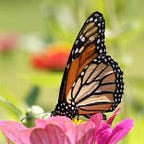FWS Behind the Lens: Becky Harrison
Becky Harrison grew up in the suburbs outside of Detroit, Michigan and photography has always been a hobby of hers. She’s been behind the lens capturing wildlife, nature, and beautiful scenery ever since she got her first camera — a Kodak 110 — when she was 9 years old. Becky’s uncle gave her an old Konica SLR that was her grandfather’s and she used that throughout high school and developed her own black and white film. Currently, she uses digital SLRs, which are much lighter in weight compared to what she hauled around during her college backpacking days.
“When I started hiking more in college, photography was key to documenting my explorations,” Becky shared.
Both of Becky’s grandfathers influenced her appreciation for the natural world, one of which was a hobby farmer and the owner of a florist business. She would visit the family farm, play outside with rescued horses, sheep, cows, and barn cats or plant flowers, veggies, and pick peaches from the orchard. These childhood experiences instilled in her a love for animals, which would lead her to become the Zoologist and Biologist she is today!
She completed her undergraduate degree at Michigan State University in Zoology with a concentration in Neurobiology and Animal Behavior. Later, she earned a Master’s of Science in Wildlife Biology from Utah State University, where she studied predator-prey dynamics, including coyote and several prey systems in the Great Basin. Then she moved across the mountains to go to North Carolina where she went to North Carolina State University for a Ph.D. in Zoology with minor in Botany. She studied how beaver disturbance influenced habitat dynamics of the endangered St. Francis satyr butterfly. After her last degree, Becky completed 3 years of post-doctoral work with the National Institutes of Health at the University of Georgia. She researched how animal migration strategies affects infectious diseases and used the monarch butterfly as a model system.
Becky took a job as the first Terrestrial Ecologist with the South Atlantic Inventory and Monitoring Network for the U.S. Fish and Wildlife Service. After a difficult decision, she decided to leave that fantastic team and become the Assistant Recovery Coordinator for the Red Wolf Recovery Team. She’s been in her current role as Supervisory Biologist at the Coastal NC Wildlife Refuge Complex since July 2016.
Her favorite part of what she does is working with her team in the field. She really enjoys the hands-on work and collaborative projects with partners. “Working with endangered species and at-risk species is both gut-wrenching and rewarding,” Becky explains. It’s a painful reality to lose individuals when you know each contributes significantly to the population dynamics of the species, but it’s also really powerful to see things when they work in a given system. Becky has been working with the endangered St. Francis satyr in North Carolina since she was in grad school in 2003 and it’s taken her on a rollercoaster as the population crashed and recovered. However, observing partners make breakthroughs in captive propagation and restoration work has been an incredible inspiration to her. Similar with working with endangered red wolves, it’s been tough for her and the team to watch the population decline in recent years.
“Every loss feels very personal at that scale. However, the partnerships, especially in the species survival plan cooperators, and the dedication of the field personnel are a constant motivation in navigating some tough issues.”
Photography for her is a way to connect to these special places and species in a different way. When she’s working regularly on the refuges, she sometimes can take some of these interactions for granted. Being behind the lens gives Becky a different perspective and helps her appreciate being more in the present. Photography helps her slow down as well. The field season is intense and requires immediate action and concurrent prioritization of many different activities. Photography is a slower, sensory-filled experience that requires an adjusted pace, allowing her to do one thing at that time, which gives her a better appreciation of the light, environment, and the beauty of it all.
One thing Becky is passionate about is championing the underdog, and that motivates her when endangered species conservation gets really challenging! It’s also really important for her at this stage in her career to serve as a good mentor to interns, volunteers, and students she collaborates with. Becky has benefitted from some amazing early experiences that shaped her professional path. Many of those opportunities were results from someone advocating for her, so she believes it’s her turn to provide that support and create those opportunities for others.
“Another thing I’m really passionate about is continuing to explore how to connect with nature. That idea means something different to everyone, but for me being in nature is part of my overall wellness.”
Finding space outside has always been important to her, but has become a critical part of her routine and self-care during the pandemic. Everyone deserves that opportunity and she sees refuges playing important roles in providing that space for so many people. Becky believes, “it’s a responsibility of all the programs to provide safe and equitable options for everyone to experience nature and to be able to find their own connection.”
Through this blog, the FWS National Digital Library aims to highlight different people in the field who have contributed spectacular photography, with an eye toward reflecting the full mission of the Service. Visit us at: images.fws.gov. Brought to you by the USFWS Conservation Library. #FWSBehindTheLens #WeAreUSFWS
